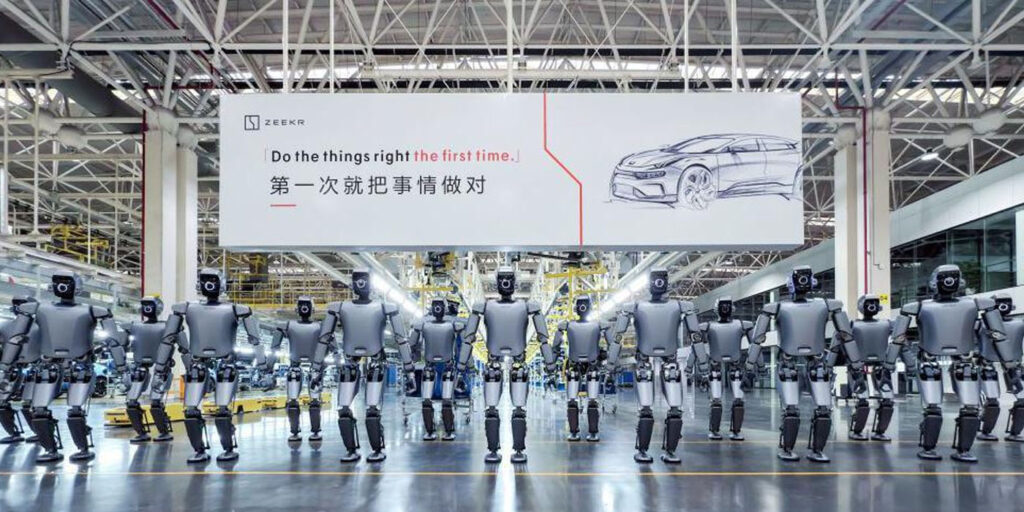China is launching its first-ever heterogeneous humanoid robot training facility, a futuristic step toward making robots to do specific tasks like industrial jobs, household works and so on.
When future is chasing for efficiency and productivity, machines always have an edge over humans. And with technologies like artificial intelligence and robotics booming up fiercely, countries strive to grasp them to lead the way. In the aspect, China has never missed a chance.
Morgan Stanley, an American Investment bank company, reported that 40,000 jobs will be taken over by ‘Humanoid robots’ by 2030, as per estimates. This humanoid-robot’s training hub in China adds more sense to it.
Robot Training-hub
China is taking a bold step into the future of robotics with the launch of its first heterogeneous humanoid robot training facility, set to become fully operational in July. This groundbreaking initiative, known as the National and Local Co-built Humanoid Robotics Innovation Center, located in Shanghai’s Zhangjiang area, spans over 5,000 square meters and is poised to revolutionize the development and application of humanoid robots.
What makes this facility unique is its focus on heterogeneous robots – robots with varying structures and functional modules from different manufacturers. The center is currently training over 100 types of robots from more than a dozen enterprises, making it the largest collection of robot varieties in the country undergoing training. This diverse environment aims to tackle a key challenge in the industry: the incompatibility of data generated by robots with different designs. The ultimate goal is to enable large-scale data sharing and utilization, empowering the entire humanoid robot industry.
Imparting Foundational Skills
The initial phase of training will concentrate on approximately 45 fundamental or “atomic” skills, such as grasping, picking, placing, and transporting. Through the simulation of everyday and workplace scenarios, the robots will learn to perform these actions and build an atomic skill library for robotic manipulation tasks in various sectors, including industrial, service, medical, and agricultural fields.
You may also like to Read this: Meet ‘Emo’, a smart little desktop Pet-Robot who does what you say
By repeatedly performing these actions, often up to 600 times a day with human trainers replicating movements, the robots learn from the motion data collected. Even subtle differences in the size, shape, and placement angle of objects during “grasping” generate unique data points that help the robots adapt to different environmental conditions.
The training focuses on 10 key scenarios, including industrial, domestic, and tourism services, with tasks broken down into specific actions like folding clothes, organizing shelves, and cleaning large equipment in hazardous environments.
Building a “Super Brain” for Collaborative Robotics
The center is currently in a testing phase, generating 20,000 to 30,000 data entries daily, with expectations to reach 50,000 daily entries and over 10 million real-machine data entries within the year once fully operational. Looking ahead, the facility plans to establish a data exchange platform to allow robot companies to share data from diverse scenarios like home appliances and healthcare, reducing redundancy and significantly improving efficiency.
The ultimate vision is to utilize the training data from these diverse robots to develop a general-purpose embodied intelligence foundation model, often referred to as a “super brain”. This central model would enable robots from different manufacturers and of different forms to collaborate efficiently and upgrade together under a unified command. This initiative is seen as foundational infrastructure for AI development, bridging hardware, software, and big data collection.
This ambitious project signifies China’s commitment to becoming a leader in the humanoid robot industry by fostering innovation, collaboration, and the development of advanced AI capabilities. The success of this training hub could pave the way for humanoid robots to become more adept at everyday manual tasks, potentially complementing or even replacing human labor in various sectors. The world is keenly watching as this groundbreaking facility prepares to unleash a new era of intelligent machines.
(For more such interesting informational, technology and innovation stuffs, keep reading The Inner Detail).
Kindly add ‘The Inner Detail’ to your Google News Feed by following us!







